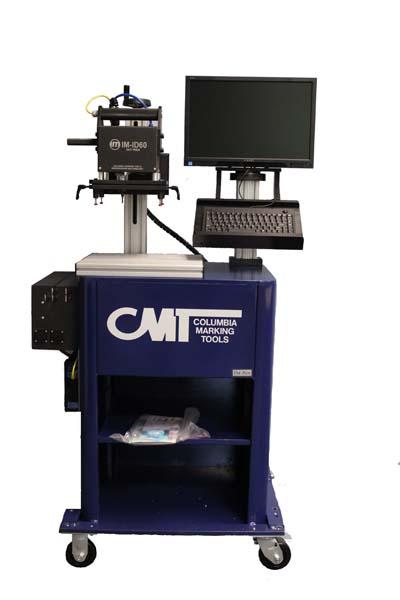
I-Mark H Series from Columbia Marking Tools is a combination bench-top/handheld dot peen system that is easily programmable and marks metal, plastic or wooden parts at high speed (up to 4 characters per second). It gives users the flexibility to do linear, angular, circular, and even 2-D data matrix imprinting as well as the choice of operating in bench-top or handheld mode.
The I-Mark H Series is a turnkey system that sets up easily and comes with everything necessary for precise, repeatable marking: pneumatic dot peen marking head with carbide pin; multiple character fonts, including optical character recognition (OCR); compact controller with preloaded software; bench-top stand with quick-release feature; 17" color monitor; full-size keyboard with integrated mouse; and all required cables.
The bench top stand has a 12" x 14" (305mm x 380mm) T-slot table for parts fixturing and a column that is easily adjusted for parts at tall as 12" (305mm). The system can be ordered with a medium or large marking window, 1.59" x 2.35" (40mm x 60mm) or 3.18" x 7.87" (80mm x 200mm). An optional cart is available for users who desire mobility, as well as custom part locating stand-off.
The preloaded I-Mark software offers a graphical user interface with simple icons that make it easy to set up the marking layout without programming experience. It features drag-and-drop functionality, video demonstrations and an extensive help file. A marking simulator allows users to test marking positions before actually marking a part, and advanced system diagnostics are provided.
The compact I-Mark 200 controller, designed to be easily integrated into production equipment, comes in a rugged NEMA 4 enclosure with digital I/O and a data input port for a barcode scanner. Communication options include operation via I/O, Modbus, Serial or ethernet IP, and remote programming over LAN. Database and camera integration are also available.
Contact Details
Related Glossary Terms
- 2-D
2-D
Way of displaying real-world objects on a flat surface, showing only height and width. This system uses only the X and Y axes.
